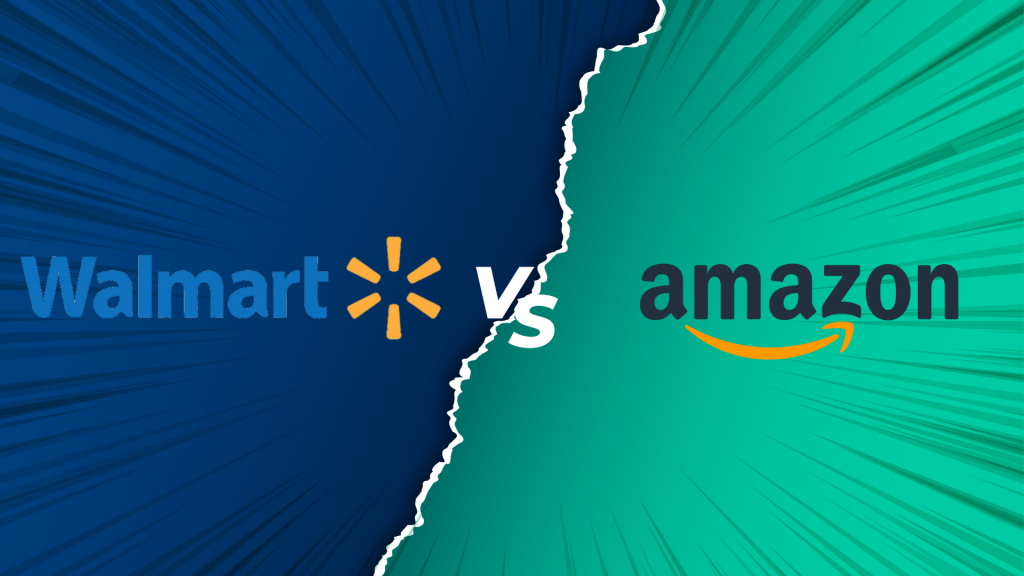When running an ecommerce business, choosing the right marketplace can often be the defining factor in the business’s success. With giants like Walmart and Amazon on the table, it can be hard to make the right decision.
We want to explore what Walmart and Amazon have under the hood as potential platforms for ecommerce businesses to help you make a more informed decision.
What is Walmart as a marketplace?
Walmart is a multinational retail corporation that operates a chain of hypermarkets, discount department stores, and grocery stores. In addition to its physical retail presence, Walmart has also expanded into the realm of e-commerce with its online marketplace.
Walmart’s ecommerce platform provides a digital marketplace for third-party sellers to offer their products to a vast online customer base. Similar to other ecommerce giants like Amazon and eBay, Walmart’s online marketplace allows independent sellers, brands, and retailers to list and sell their products directly to consumers through the Walmart website.
What does it offer for sellers?
For sellers, Walmart’s ecommerce marketplace offers several benefits:
- Massive customer base
Walmart’s online presence attracts millions of shoppers, providing sellers with access to a wide audience. - Brand recognition
Associating with the Walmart brand can lend credibility to sellers, potentially boosting consumer trust. - Diverse product categories
Sellers can offer a wide range of products across various categories, including electronics, clothing, home goods, and more. - Fulfillment options
Walmart provides fulfillment services, allowing sellers to store their products in Walmart fulfillment centers. This enables sellers to offer fast shipping and leverage Walmart’s logistics infrastructure. - Marketing opportunities
Sellers can take advantage of Walmart’s advertising and promotional tools to enhance their product visibility. - Competitive fees
While fees may vary, Walmart’s marketplace is known for having relatively competitive commission rates compared to other major e-commerce platforms. - Quality standards
Walmart maintains certain quality standards for products sold on its platform, aiming to ensure customer satisfaction and protect the Walmart brand. - Integration options
Sellers can integrate their systems with Walmart’s APIs to manage inventory, orders, and other aspects of their business more efficiently. - Customer trust
Being associated with a well-known retail brand like Walmart can help instill trust and confidence in potential customers. - Customer service
Walmart handles customer service, including returns and inquiries, for products sold through its marketplace, relieving sellers of some support responsibilities.
What is Amazon as a marketplace?
Amazon is one of the world’s largest and most well-known e-commerce marketplaces. It was founded in 1994 by Jeff Bezos and has since evolved into a global conglomerate offering a wide range of products and services. The company initially started as an online bookstore but quickly expanded its offerings to include virtually every category of goods imaginable, from electronics and clothing to household items and groceries.
What does Amazon offer for sellers?
For sellers, Amazon offers several platforms and programs to enable them to reach a vast customer base and sell their products. Here are some key features and offerings for sellers on Amazon:
- Marketplace
Amazon provides a platform where individual sellers and businesses can list their products for sale. The marketplace model allows sellers to leverage Amazon’s immense customer base and infrastructure to reach a global audience. - Fulfillment by Amazon (FBA)
This program allows sellers to store their products in Amazon’s warehouses. When an order is placed, Amazon handles the packing, shipping, and customer service. This enables sellers to offer Prime shipping benefits to customers and simplifies the logistics process. - Seller Central
Seller Central is a web interface that sellers use to manage their product listings, inventory, orders, and customer interactions. It’s a hub for sellers to monitor their performance and make necessary adjustments. - Amazon advertising
Sellers can promote their products through Amazon’s advertising services, including sponsored product ads and display ads. These ads help products stand out in search results and other prominent placements on the platform. - Brand registry
For registered brand owners, Amazon offers tools to protect their intellectual property and control how their products are presented on the platform. - Amazon Handmade
This platform is specifically designed for artisans and crafters to sell their handmade products to a wide audience. - Amazon launchpad
A program that helps startups and innovative brands launch and promote their products on Amazon’s platform. - Amazon Stores
Sellers can create their own customized storefronts within Amazon to showcase their brand and product offerings. - Global Selling
Amazon enables sellers to expand their reach by selling and reselling on Amazon their products internationally, reaching customers in various countries. - Seller support and education
Amazon provides resources, tutorials, and customer support to help sellers navigate the platform effectively and grow their businesses. - Reviews and ratings
Customers can leave reviews and ratings for products they purchase, which can significantly impact a seller’s reputation and sales performance. - Subscription programs
Amazon offers subscription-based programs such as Amazon Prime, which can help sellers attract loyal customers with benefits like free shipping and exclusive deals.
Selling on Amazon can be highly competitive due to the platform’s popularity, but it also provides immense opportunities for businesses to reach a vast customer base and grow their sales. It’s important for sellers to understand the platform’s rules and guidelines, optimize their product listings, provide excellent customer service, and adapt to changing market dynamics.

Requirements for launching your business on Walmart or Amazon
Walmart and Amazon offer different paths for ecommerce sellers. Walmart’s strict requirements focus on established US businesses, emphasizing reliability. In contrast, Amazon welcomes a wide range of sellers, from newcomers to international entrepreneurs. Evaluating these conditions based on your business’s status and goals will help you choose the right fit for your selling journey.
Let’s break it down.
Walmart’s requirements
Walmart’s marketplace, known for its discerning approach, caters to established businesses aiming to extend their reach. The registration eligibility criteria on Walmart are stringent, designed to uphold quality and reliability. Prospective sellers must meet these qualifications and provide specific documentation:
- US Business Tax ID
Unlike Amazon, which accepts Social Security Numbers (SSNs), Walmart mandates a valid US Business Tax ID for registration. - W9 or W8 and EIN verification letter
Proof of your US business address or physical operations, along with an EIN Verification Letter from the Department of Treasury, is essential. - Address or place of physical operations
You need to provide a verifiable US business address or location. - Planned integration method
Detail your intended method for integrating your product catalog, such as bulk upload, API, or through a solution provider. - Product information
Furnish primary product categories, catalog size, total SKUs, and additional data like UPC information and product condition (new, used, refurbished, etc.).
Currently, Walmart exclusively accepts applications from businesses registered within the United States. It’s important to note that any potential alterations to this policy by Walmart remain uncertain.
In addition to these general requirements, businesses using Walmart Fulfillment Services (WFS) must adhere to specific product criteria:
- US fulfillment
Products must originate from within the United States and be shipped to Walmart’s fulfillment centers. - Restricted products
Perishable and regulated items are prohibited from WFS. - Weight and dimensions
Products must weigh under 30 lbs and fit within dimensions of 25″x20″x14″.
Amazon requirements
In stark contrast to Walmart’s stringent prerequisites, Amazon’s entry barriers are lower, making it a favorable choice for new and inexperienced sellers. Amazon streamlines the registration process, emphasizing accessibility and a diverse seller base. To initiate your selling journey on Amazon, the following essentials are required:
- Bank account and routing number
Facilitate transactions by providing your bank account and routing numbers. - Chargeable credit card
Furnish details of a credit card capable of processing charges. - Government-issued national ID
Submit a valid government-issued identification for verification purposes. - Tax information
You have the flexibility to use your Social Security Number (SSN) for tax-related information. - Phone number
A functional phone number is necessary for communication. - Residency and international selling
Unlike Walmart’s US-exclusive policy, Amazon opens its doors to international sellers from select countries. Residency in one of these eligible countries, along with an internationally chargeable credit card and valid phone number, is essential.
Consequently, Amazon offers a broader scope for international participation, expanding its reach and diversifying its seller ecosystem.
How much will they charge you: a look at the seller fees
Understanding a platform’s seller fees is essential when selecting where to sell. It enables accurate cost assessment, profit calculation, and budgeting. This knowledge guides investment decisions, ensures long-term sustainability, and prevents hidden costs. Moreover, it shapes sales strategies and aligns offerings with the platform’s audience. Ultimately, fee awareness maximizes overall business profitability.
Now, let’s look what sellers might be charged in fees when selling on Walmart or Amazon
Walmart’s seller fees
Walmart’s seller fees can vary depending on the specific category, type of product, and your business arrangement with the platform. Walmart uses a referral fee model, where you pay a percentage of the item’s sale price as a fee for using their platform. Additionally, there might be subscription fees for specific seller tiers that offer additional features and benefits.
Let’s look at them in more detail.
- Referral Fees
A percentage of the item’s sale price paid to Walmart as a fee for using their platform to sell products. - Subscription Fees
Optional subscription tiers that offer varying features and benefits for sellers. Higher tiers might provide additional tools and exposure, but they come with a monthly fee. - Refund Administration Fee
This fee could be applied in certain cases where a customer’s refund is not handled through the standard process. - Return Refund Fee
If a customer’s return is not properly processed, this fee might be charged. - Highly Visible Item Fee
If you choose to promote your product for increased visibility, this fee might apply. - Shipping Override Fee
If the shipping cost you set is significantly different from the actual shipping cost, this fee could be charged. - Order Defect Rate
While not a fee per se, if your order defect rate is high, you might lose eligibility for the Walmart marketplace.
Important note: Please be advised that fee structures can change, and there might be additional fees or changes to the ones listed above. It’s crucial to consult Walmart’s official seller resources or contact their support for the most accurate and current information on their seller fees.
Amazon seller fees
Amazon seller fees encompass various costs associated with selling products on the Amazon platform. These fees can include:
- Referral Fees
These are a percentage of the item’s sale price (excluding taxes) that you pay to Amazon. The percentage varies depending on the category of the product. - Fulfillment Fees
If you use Amazon’s fulfillment services (FBA), you’ll pay fees for storage, picking, packing, and shipping your products. These fees vary based on the product’s size and weight. - Subscription Fees
Amazon offers a Professional selling plan with a monthly subscription fee and an Individual selling plan with per-item fees. The Professional plan is suitable for high-volume sellers. - Closing Fees
These apply to media products (books, DVDs, etc.) and are charged per item sold. - Refund Administration Fees
If you refund a customer for an order, Amazon might charge a refund administration fee. - High-Volume Listing Fees
If you exceed a certain number of active listings, Amazon might charge additional fees. - Advertising Fees
If you use Amazon’s advertising services to promote your products, you’ll incur advertising costs. - Storage Fees
These apply if your products are stored in Amazon’s fulfillment centers for an extended period. - Long-Term Storage Fees
Charged if your products remain in Amazon’s fulfillment centers for an extended period (usually over 365 days). - Shipping Fees
If you fulfill orders yourself (MFN), you’ll be responsible for shipping costs.
It’s important to note that Amazon’s fee structure can be complex and may vary by region and category. Before selling on Amazon, it’s crucial to review their detailed fee schedule to understand how these fees might impact your business’s profitability and pricing strategy.
Walmart’s and Amazon digital payment options
Both Amazon and Walmart offer a range of payment options to cater to the diverse preferences of their customer base. Sellers on these platforms also have specific payment methods and options available for receiving payouts for their sales, which can vary based on factors like location, business type, and platform policies.
Below, we’re breaking down the common payment options sellers can offer their customers when selling on Walmart and Amazon.
Amazon payment options
- Amazon Pay
Amazon Pay is Amazon’s own payment processing service that allows customers to use their Amazon account information to make purchases on external websites. It offers a familiar and trusted checkout experience. - Amazon pay later
This feature lets eligible customers make purchases and pay for them over time. It’s a form of buy-now-pay-later option. - Credit and debit cards
Amazon accepts various major credit and debit cards for payment. - Amazon gift cards
Customers can use Amazon gift cards to pay for purchases on the platform. - Amazon Store Card and Amazon Credit Card
Amazon offers its store card and credit card options, providing special financing and rewards for Amazon purchases. - Amazon Cash: This allows customers to add cash to their Amazon balance by visiting participating retailers and adding funds to their account.
Walmart payment options:
- Credit and debit cards
Walmart accepts major credit and debit cards for online purchases. - Walmart Pay
Walmart’s mobile payment solution allows customers to link their payment methods and make purchases in-store through the Walmart app. - Gift cards
Walmart gift cards can be used for online purchases. - Pay with Cash (in-store)
Walmart allows customers to order online and pay with cash at a physical store location. - Affirm
Walmart partners with Affirm to offer installment payment options for eligible customers. - Walmart Credit Cards
Walmart offers credit cards that can be used for purchases, providing special financing options.
An overview of shipping options
Walmart and Amazon, prominent players in online commerce, provide distinct shipping choices for customers and sellers.
Amazon Prime and other Amazon’s shipping options
Amazon Prime is a subscription service offering fast and often free shipping for qualifying items. The Fulfillment by Amazon (FBA) program involves storing products in Amazon’s warehouses, with the company handling packaging, shipping, and customer service. Merchants can also fulfill orders themselves through the Merchant Fulfilled Network (MFN). Amazon further caters to grocery and household needs through Amazon Fresh and Amazon Pantry.
Walmart’s shipping options
Walmart presents standard shipping options with delivery times ranging from a few days to a week. Walmart+ is a subscription service offering unlimited free delivery on eligible items along with fuel discounts. The NextDay Delivery service provides swift delivery for various eligible items. In-store pickup allows online orders to be collected from nearby physical stores. Walmart extends fulfillment services akin to Amazon’s FBA and features grocery delivery and pickup services.
Your selection between the two platforms may hinge on the speed, cost, and convenience of their shipping alternatives, as well as the availability of these services in your location. Both companies consistently refine their offerings to align with evolving customer expectations and industry competition.
Factors to consider when choosing the right marketplace for your business
With so many feature offered, it can be sometimes difficult to deside which platform or marketplace to go with. Even considering defferent scopes of fees, some other factors can compensate for a more expensive option. So, it may be unobvious, at the first glance, what marketplace might fit your business better.
At this point, we recommend looking deeper under what you see on the surface and assess more factors to come up with the right decision. Below are the factors you might want to consider whan choosing the right ecommerce marketplace for your business.
- Target audience and market reach
Identify the marketplace’s customer base and whether it aligns with your target audience. Consider the marketplace’s geographic reach and whether it can help you tap into new markets. - Product fit
Evaluate whether your products align with the marketplace’s niche or category. Some marketplaces specialize in specific product types, so ensure your offerings are a good fit. - Fees and pricing structure
Understand the marketplace’s fee structure, including listing fees, transaction fees, subscription fees, and any other potential costs. Compare these fees with your projected revenue to ensure they are sustainable for your business. - Competition and visibility
Research the competition within the marketplace. Determine whether your products will stand out or get lost among a sea of similar offerings. Look into how the marketplace handles product search rankings and visibility. - Brand control
Consider whether the marketplace allows you to build and maintain your brand identity. Some marketplaces offer customization options, while others might limit how you present your brand. - Ease of use
Evaluate the marketplace’s user interface and overall user experience. A user-friendly platform can make it easier for you to manage your listings, track orders, and handle customer interactions. - Seller support and resources
Look into the level of support the marketplace provides to sellers. This includes customer service, seller education, and resources for optimizing your listings and sales. - Seller policies
Review the marketplace’s seller policies, including return and refund policies, shipping options, and any restrictions on the types of products you can sell. - Payment and transactions
Understand the payment methods and transaction processing used by the marketplace. Consider whether the payment process aligns with your preferences and provides a secure environment for both you and your customers. - Customer base and traffic
Research the marketplace’s existing customer base and traffic volume. High-traffic marketplaces offer the potential for more visibility, but also mean higher competition. - Integration and tools
Check whether the marketplace offers integration with e-commerce tools and software you already use or plan to use. This can streamline your operations and make managing your business more efficient. - Data and analytics
Look for marketplaces that provide robust data and analytics tools. These insights can help you understand customer behavior, track sales trends, and optimize your strategy. - Long-term viability
Assess the marketplace’s track record and reputation. Consider whether the marketplace has a history of growth and innovation or if it’s showing signs of decline. - Terms and conditions
Carefully read and understand the marketplace’s terms and conditions. This includes policies related to intellectual property, privacy, and any exclusivity agreements. - Scalability
Think about your business’s growth potential. Will the chosen marketplace support your scaling efforts, both in terms of the number of products you offer and the volume of sales? - Mobile-friendliness
With the increasing use of mobile devices for shopping, ensure that the marketplace provides a mobile-friendly experience for both sellers and buyers. - Reviews and feedback
Seek out feedback from other sellers who are already using the marketplace. Their experiences can provide valuable insights into potential challenges and benefits. - Marketing and promotion
Investigate whether the marketplace offers marketing and promotional tools to help you boost your sales, such as advertising options or featured listings.
Remember that each business is unique, and what works for one may not work for another. Take the time to thoroughly research and analyze your options to choose the e-commerce marketplace that aligns best with your business goals and strategies.
Final word
As you can see, both Walmart and Amazon offer distinct advantages for e-commerce sellers, and the choice between them depends on individual business goals. Amazon’s vast reach and fulfillment network provide global visibility, while Walmart’s focus on quality appeals to a discerning audience. Consider factors like target market, product uniqueness, and long-term objectives when deciding. Many sellers find success by leveraging both platforms. In this dynamic e-commerce landscape, adaptation and a strong strategy are essential for thriving on either Walmart or Amazon.

.png)




